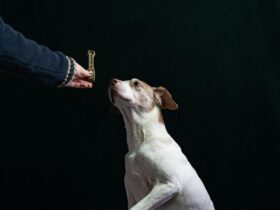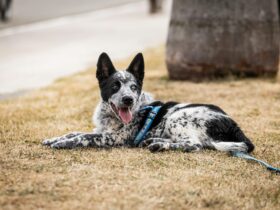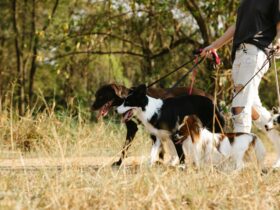Cycling with your dog can be a thrilling and healthy activity for both of you, but it requires preparation, training, and an understanding of your dog’s needs. Here’s a comprehensive guide on the dos and don’ts to ensure a safe and enjoyable experience for you and your furry companion.
1. Choosing the Right Equipment
Do: Invest in a Suitable Leash or Harness
- Bike Leashes: Look for a bike-specific dog leash, designed to keep your dog at a safe distance from the wheels. These leashes usually attach to the bike’s frame and provide a secure yet comfortable tether.
- Harness vs. Collar: A harness is preferable over a collar for biking, as it distributes the pulling force evenly across your dog’s body, reducing the risk of injury.
Don’t: Use a Regular Leash
- A standard leash can easily get tangled in the bike’s wheels or chain, posing a severe hazard to both you and your dog.
2. Assessing Your Dog’s Suitability for Biking
Do: Consider Your Dog’s Breed and Temperament
- Active Breeds: Breeds like Border Collies, Labrador Retrievers, and Huskies generally have the stamina and enthusiasm for running alongside a bike.
- Calm Dispositions: Dogs with calm temperaments are easier to train for biking and are less likely to get spooked by traffic or other distractions.
Don’t: Force Biking on an Unwilling Dog
- Not all dogs are suited for running alongside a bike. Elderly dogs, puppies, and breeds with respiratory issues (like Pugs or Bulldogs) should avoid strenuous activities like biking.
3. Training Your Dog for Cycling
Do: Start With Short Walks and Gradual Training
- Leash Training: Begin by walking your dog on a leash next to the bike, rewarding them for staying close without pulling.
- Introduce the Bike Slowly: Let your dog get used to the bike by walking it alongside them without riding. Gradually increase the exposure until they are comfortable.
- Short, Controlled Rides: Start with short rides in a controlled environment, such as a quiet park, to gauge your dog’s reaction.
Don’t: Rush the Training Process
- Pushing your dog too quickly can lead to anxiety and unsafe behaviors. Training should be slow, with plenty of positive reinforcement.
4. Ensuring Safety During the Ride
Do: Prioritize Safety Gear
- Reflective Gear: Equip both yourself and your dog with reflective gear, especially if you’ll be cycling in low-light conditions.
- Helmet and Pads: Always wear a helmet, and consider protective gear for your dog’s paws if cycling on rough terrain.
Don’t: Forget About Hydration and Breaks
- Dogs can overheat quickly, especially on hot days. Bring plenty of water and take regular breaks to let your dog rest and cool down.
5. Choosing the Right Path and Time
Do: Opt for Dog-Friendly Paths
- Off-Road Trails: Choose bike paths that are wide, smooth, and free from heavy traffic. Off-road trails or designated dog-friendly routes are ideal.
- Early Morning or Late Evening Rides: Cycling during cooler parts of the day reduces the risk of heatstroke and keeps your dog more comfortable.
Don’t: Ride in High-Traffic Areas
- Busy streets with lots of cars, pedestrians, and noise can be stressful and dangerous for your dog. Stick to quieter paths where you can maintain control.
6. Monitoring Your Dog’s Health and Behavior
Do: Watch for Signs of Fatigue or Stress
- Paw Checks: After each ride, check your dog’s paws for cuts, abrasions, or signs of wear.
- Behavioral Cues: Keep an eye on your dog’s behavior. Panting, lagging behind, or reluctance to keep pace can indicate that they need a break.
Don’t: Ignore Warning Signs
- If your dog shows signs of discomfort, distress, or fatigue, stop immediately. Pushing them too hard can lead to injuries or long-term aversions to biking.
7. Legal and Ethical Considerations
Do: Follow Local Laws and Etiquette
- Leash Laws: Ensure that biking with a dog on a leash is legal in your area. Some places may have specific regulations about where and how dogs can be attached to bikes.
- Respect Other Path Users: Be mindful of pedestrians, other cyclists, and dog walkers. Keep your dog close and under control to avoid accidents.
Don’t: Disregard Public Safety
- Always maintain control of your dog, and avoid biking in areas where your dog could pose a danger to others or themselves.
8. Alternative Options for Biking With Dogs
Do: Consider a Dog Trailer or Basket
- Dog Trailers: For dogs that are unable to run long distances, a dog trailer attached to your bike allows them to enjoy the ride without the physical exertion.
- Front or Rear Basket: Smaller dogs can ride in a well-secured basket, but ensure it’s stable and designed for pet transportation.
Don’t: Overload the Trailer or Basket
- Make sure the trailer or basket is suitable for your dog’s weight and size. An overloaded basket or trailer can destabilize the bike and lead to accidents.
Conclusion
Biking with your dog can be a wonderful way to bond and stay active together. By following these dos and don’ts, you can ensure that your cycling adventures are safe, enjoyable, and stress-free for both you and your canine companion. Remember, preparation and attentiveness to your dog’s needs are key to making every ride a success.











Leave a Reply